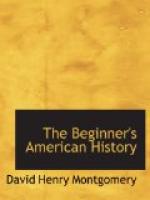He returned to America a number of years later, explored the coast north of Virginia, and gave it the name of New England, but he never went back to Jamestown again. He died in London, and was buried in a famous old church in that city.[8]
[Footnote 8: The church of St. Sepulchre: it is not very far from St. Paul’s Cathedral.]
47. What Captain Smith did for Virginia.—Captain John Smith was in Virginia less than three years, yet in that short time he did a great deal. First, he saved the settlers from starving, by making the Indians sell them corn. Next, by his courage, he saved them from the attacks of the savages. Lastly, he taught them how to work. Had it not been for him the people of Jamestown would probably have lost all heart and gone back to England. He insisted on their staying, and so, through him, the English got their first real foothold in America. But this was not all; he wrote two books on Virginia, describing the soil, the trees, the animals, and the Indians. He also made some excellent maps of Virginia and of New England. These books and maps taught the English people many things about this country, and helped those who wished to emigrate. For these reasons Captain Smith has rightfully been called the “Father of Virginia.”
[Illustration: A settler’s log cabin.]
48. Negro slaves sent to Virginia; tobacco.—About ten years after Captain Smith left Jamestown, the commander of a Dutch ship brought a number of negro slaves to Virginia (1619), and sold them to the settlers. That was the beginning of slavery in this country. Later, when other English settlements had been made, they bought slaves, and so, after a time, every settlement north as well as south owned more or less negroes. The people of Virginia employed most of their slaves in raising tobacco. They sold this in England, and, as it generally brought a good price, many of the planters[9] became quite rich.
[Footnote 9: Planter: a person who owns a plantation or large farm at the South; it is cultivated by laborers living on it; once these laborers were generally negro slaves.]
49. Bacon’s war against Governor Berkeley;[10] Jamestown burned.—Long after Captain Smith was in his grave, Sir William Berkeley was made governor of Virginia by the king of England. He treated the people very badly. At last a young planter named Bacon raised a small army and marched against the governor, who was in Jamestown. The governor, finding that he had few friends to fight for him, made haste to get out of the place. Bacon then entered it with his men; but as he knew that, if necessary, the king would send soldiers from England to aid the governor in getting it back, he set fire to the place and burned it. It was never built up again, and so only a crumbling church-tower and a few gravestones can now be seen where Jamestown once stood. Those ruins mark the first English town settled in America.




